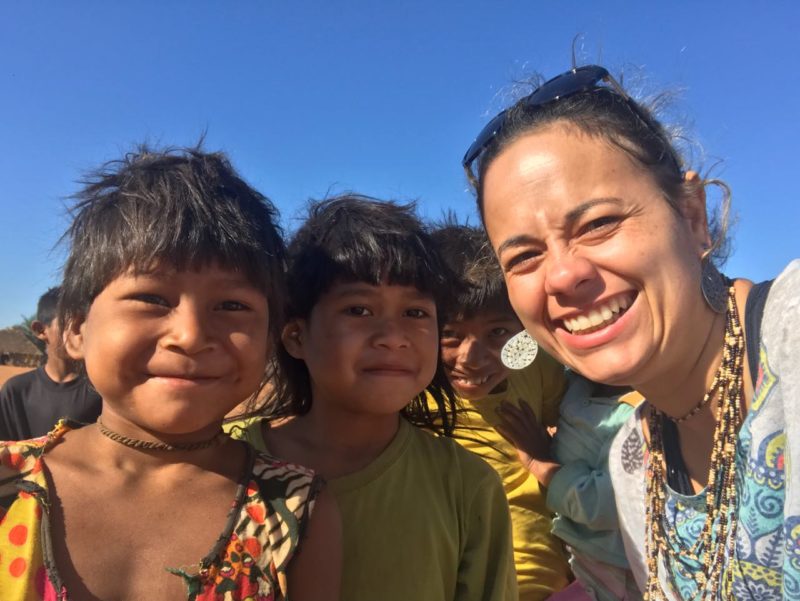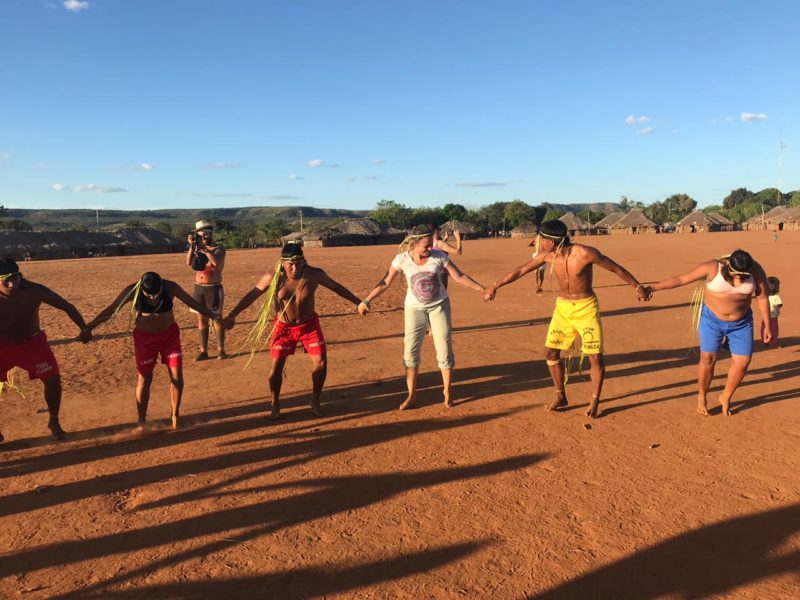article written by Marianne Costa to Folha de S. Paulo newspaper
Chief of a Xavante village, in Mato Grosso, explains that tourist visitation is part of their strategy
I have recently returned from a trip to the Xavante indigenous village Etenhiritipá, and that was one of the most beautiful and special experiences of my life. And I basically have wheels on my feet and wings on my back, my friends would say. I spent a few days – enough to lose track of time, calendar, no clock, cell phone or internet – near the municipality of Canarana, in Mato Grosso state.
I travelled from Goiânia to there on a bus trip of more than 12 hours, where we have gathered a very special group, led by Israel and Tadeu, from Ambiental tour operator. It was a very old school bus, but perfect for the precarious roads that we would face for almost two hours until we arrived in the village (it may be a bit more, or less, but I really lost this kind of control).
As a travel and tourism professional, without even having started the journey, I was already worried about how we could enjoy a more comfortable logistics from the tourist’s experience perspective. When we arrived there and after all the experience, I realised how much all the journey, the long waits, the carrying and unloading of luggage, the changes of coats, made sense to the trip.
All these apparent distresses for us, urban citizens, accustomed to the total control of everything, were preparing us for this peculiar experience: a true disruption of stigmas, prejudices, ingrained values and senses. I still don’t know if I will be able to deliver the depth of the experience, which, of course, is as unique and personal as the soul of each individual present there.
Strength and Resistance
We were received by Jurandir Siridiwe, chief and main leader at the village. Jurandir is one of those who speaks good Portuguese, since he was part of a Xavante group of boys who, in the 70’s, was sent out of the village to study and learn about the “white people invaders” culture.
Apparently, the Xavantes surrendered in the 1940s, when they gave up fighting with weapons and accepted the “civilizing” contact of the white man. In fact, this initiative was part of a strategy that they understood as necessary. They needed to make peace with white invaders and, in that case, it was necessary to dominate their culture. As a first result, in 1988 the Xavantes had their territory and reserve legalised, and now it is one of the villages of the indigenous territory Pimentel Barbosa, where currently live 3,200 people.
Xavantes are traditionally warriors. They speak and live the motto of strength and tenacity among men, women and children. The strength and courage can be observed in every detail of their day-to-day activities and in their stories. Even pet dogs are extremely brave, excellent watchdogs and loyal to the owners and homes they protect.
Jurandir began by explaining that tourism visitation is part of the Xavante’s strategy. For that peaceful people, true warriors are always at war and each individual fights with the weapons he has. And a true warrior has a strategy. The Xavantes fight for their survival, for land and for human rights.
The main enemy of the Xavantes today is agribusiness and the illegal expansion of the agricultural boundary through the invasion and squatting of indigenous lands. Ignorant Indians? I’m sorry, but ignorant are those who think that Indians are stupid, lazy, do not work and other bizarre things that we often hear.
Let me recall a little bit about the history of indigenous peoples: “Since the world is a world, the Indians were already here in this territory called Brazil.” Living and surviving in society, nomadic or permanent, with their customs, culture and languages of their own. So, who should have the right to these lands? Indigenous peoples or the invaders, in this case, the white Westerners?
The Xavantes realised that they couldn’t fight alone. That is why they need to open up to Brazil and to the world. According to Jurandir, “visitation is like a window to our house. You come here and decide if you continue to venerate the academics and book authors who stereotype our culture and call us Indians”.
Therefore: “Your presence here is a way for you to have another idea, another look. Our philosophy is to receive Brazilians and extinguish this stereotype”, he explained. With that said, I feel not only in the duty and obligation to tell the world what I have seen and lived there, in a simple and objective way, but also to embrace the indigenous cause.
From their daily life, I pinpoint:
- Xavantes are hardworkers. The day in the village begins between 3am and 4am with rituals of circular dances. Then there is the cold bath in the river. The cold was harsh, after all, in the Brazilian Cerrado the thermal amplitude (difference between maximum and minimum temperatures) reaches 25 degrees;
- Xavantes are very intelligent and smart. Besides knowing their traditions, rituals of passage, arts of war, natural medicine, agriculture, hunting techniques, agricultural and bio-construction methods, handicrafts and artefacts, they also know the laws of the whites and, consequently, their rights of respect, of didactics, political articulation, leadership and of differences between ways of social life. We have earned diplomacy and resistance classes;
- Xavantes are dreamers and dreams for them are a serious thing. It is through dreams that they communicate with spirituality. It is from the dreams that they obtain guidelines for life and decisions that influence the daily routine. This is how they balance the physical and spiritual worlds. Xavantes do not have ‘Pajés’ (* a Tupi-Guarani word used to refer to the figure of the counsellor or healer of tribe), they have dreamers;
- Xavantes are strategists. They receive us in their lands, tell their stories, pass their messages, but do not reveal their secrets and hardly invite us to their homes, quite rightly;
- Xavantes are cooperative. There is no room for individualism there. Leaders are always thinking about how to divide and add. In a real lecture on how to build a fair society, I heard from one of the leaders, Paul, a phrase that struck me and that sums up this collective spirit: “Europeans are focused on multiplying, you Brazilians only think of adding, accumulating, and we, the Xavantes, are guided to divide. “

Foto: Marianne Costa
School and Diversity
We met other leaders, such as Eurico and Caime, teachers at the local school, which haa students up to the 9th grade, and Paulo, uncle of Jurandir, one of the boys that also lived abroad, speaks a great Portuguese and is a talented storyteller.
We could spend hours and hours listening to all of them telling about their lives, past and present of struggles for land rights, education and survival. Stories that inspire and make us reflect on how much and for what we have had to fight until today.
For teachers, the current struggle is for the preservation and adaptation of teaching the Xavante language and culture at school, which insists on traditional and standardised didactic materials. How to teach a Xavante child that Brazil was discovered in 1500 by a Portuguese, knowing that his people had been there for generations? How to explain the four different seasons of the year and about snow for those who were born and raised in the heart of the Brazilian Cerrado?
The Xavantes continue their struggle, joining other leaders of indigenous peoples to show that, just as there are 254 indigenous peoples in Brazil, with more than 150 different languages being spoken, there are at least 255 versions of this story and at all the other disciplines “taught” in school.
The Noni Ritual
We had the privilege of following part of the boys’ initiation ritual. Xavantes believe in the cycle of life and respect their phases. Boys, during their youth, spend five years living in what they call the House of Singles. After this time, they will go through months on a ritual of initiation that involves diverse tests of strength and resistance.
We arrived exactly in the month of running contests. Every day they run, betting among them. Some days the girls run too. The whole ritual is attended by older and married godmothers and godparents, who also have their moments during the ritual months.
On the days we were there, we were able to follow the daily routine of a beautiful circular dance with Xavante songs, which took place daily around 4 am and 3 pm. (again, approximate times for me, who did not look at the clock at all!).
On the first day, we were invited to observe and learn and, only from the second day on, we were invited to join the activities. Everything happened smoothly, without any change or interference by our presence. Nothing fake and specially prepare for tourists, and that gave a lot of genuineness to our experience.
The Xavante Women
Our daily lives in the village involved very little contact with women. Besides the cultural issue (I do not know if the word would be shy, but they did not look us in the eye), the language barrier is certainly a limiting factor. Although they learn Portuguese at school, most of them do not understand or speak the language.
We were privileged again, talking with Professor Eurico about women’s and girls’ daily routine, and telling him about our curiosities, as why almost none of them had eyebrows and why they wore those clothes.
He admitted that they too were very curious about us: why we used earrings (in the Xavante culture, only men pierce the ear) or why we painted our hair. The teacher proposed a conversation between the women of the group and the Xavante girls. And it was under a Pequi tree that we put our chairs in a circle and chatted a lot.
Unfortunately, we had the translation of a man, Professor Eurico. But he had an importance and good intentions when proposing this approach. It was an unique experience to look into their eyes, to laugh together about habits like makeup, hair removal, sunglasses and trousers. Yes, the Xavante women do not wear trousers.
And something struck me: they don’t have the habit of looking themselves in the mirror. Most of them didn’t even have a mirror and it was clear that they were satisfied with their own reflection in the river waters. It was beautiful, poetic. On that day I realised that I had not even looked in the mirror since I’d gotten there. I reflected on how I haven’t missed looking in the mirror, in that context where appearance was so secondary.
Then I accomplished, as a society, how sick we are and the sacrifices we make, the money we invest, the importance we give only to appearances. We take care of our exterior so much that we leave our interior sick.
And it was in this metaphorical mirror, that I noticed one of the secrets of the Xavantes’ vitality, force and resistance: their interior is strong and healthy, because it is to the interior that they look when they dream, when they make their decisions, when they follow the cycle of life.

Foto: Marianne Costa
The visitation
Participating in an experience like this requires giving up comfort in exchange for the depth of the experience. In my case, the exhaustion of the long journey soon dissipated and gave way to excitement and curiosity for the new, the unknown.
My voice always present and even exaggerated sometimes gave way to silence. Recognizing that it was not my moment was my greatest exercise. I was not there to talk, but to listen. Listen with the ears and also with the heart. Listen to the words spoken, but especially to those not spoken.
It is incredible how the excess of technology, lights and noises of big cities quickly consume our energy and kidnaps our attention and presence. That’s how I felt there. The meaning of being present, something that only this experience reveals, and that cannot be translated into words.
I could feel the other people and myself present, as I haven’t felt in many years. Wow, how much I missed being together with real people and with myself.
Some of us slept in hammocks, and others in tents. Since it was my second experience in an indigenous village, I rapidly chose my hammock – one of the best discoveries I have made in my travels. The people from the North and Northeast of Brazil know best: sleeping in a hammock is so good. The back fits perfectly, the hammock embraces you, and that swing gets you into a sleep that I can’t remind of anything similar.
The cold night, the sky, stained only with by the dust of the stars, and the pure air that, in the last days, was dyed with the fine red mud powder scattered with the strong blow of the wind. We stayed at the school. No visiting or entering anyone’s house without being invited. The dogs would remember anyone that might forget it.
The baths were in the river. Women on one side, men on the other, just as it always was and always will be. The cold was arriving with the sunset, and it was important to be fast.
The first day, and the absence of the hot shower soon passed. Incredible how quickly one gets used to what is good and realises that these small day-to-day luxuries come are actually a compensation and make us forget what we left behind by embracing chaotic, noisy, polluted, cold and distant urban life.
My first and biggest lesson of this trip was: visiting an indigenous people requires humility.
Recognising our insignificance in the universe and our privileges as white men and women, that need so little effort to survive, is at least an exercise.
They are rich without money. They are happy without using drugs. They are wise without relying on the media or the internet. They are supportive without slobbery. They are spiritualised without religious institutions. They are loyal to their friends.
Facing the ancestral wisdom of a people that lives and survives, despite adversities, for generations and generations, and that passes, from father to son, their valuable knowledge about nature, the Earth and beyond, about the cycle of life, of death and survival, and that only recently had access to what we call technology like books, and computers, is an unique experience. Yes, leaves you astonished.
I had other lessons, some of them very personal. But I would like to make an invitation here. Get out of your comfort zone on your next trip. Allow yourself an exercise of surrender, meeting with yourself through an experience like this. If it’s going to be your first or one of the first times, you do not have to start right away by visiting an indigenous people. Start with a traditional community close to you.
Among the peoples and traditional communities of Brazil there are the quilombolas, gypsies, African matrixes, seringueiros (rubber tappers), castanheiros, babaçu coconut quebradeiras, pasture communities, faxinalenses, artisanal fishermen, marisqueiras, ribeirinhos, caiçaras, praieiros, sertanejos, jangadeiros, azorians, campeiros, varzanteiros, pantaneiros, caatingueiros, among others.
But only do this if you are open and willing to exercise humility. I can tell you from my privileged experience of being in traditional communities several times because of my work, that the benefit and positive impact will be even greater for you than for those who will welcome you openly and with a heart full of love.
Note: I congratulate my friend Israel Waligora for the persistence, sensitivity and love with which he developed this experience, at the invitation of the Xavantes of the Etenhiritipá Village. You can know more about the experience by visiting their website.
Marianne Costa
With a Bachelor degree in Tourim, Marianne founded Vivejar and was one of the co-founders of Raízes Desenvolvimento Sustentável, shortlisted for the award Prêmio Empreendedor Social de Futuro 2012
This article was first published in: https://www1.folha.uol.com.br/empreendedorsocial/2018/08/visitar-um-povo-indigena-requer-humildade.shtml






